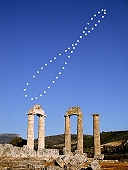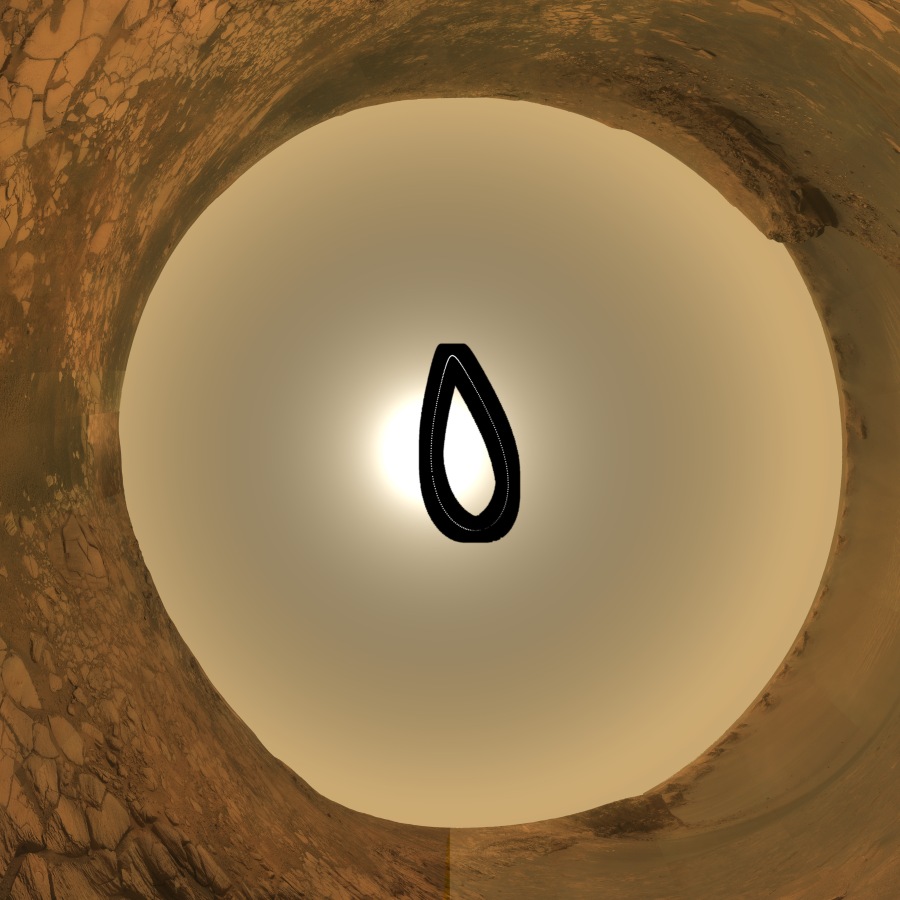
Part 2 of this little series looks at a different phenomenon to do with the sun’s movement through the sky. Imagine yourself picking a time of day – let’s say 10:30 in the morning – and taking note of where the sun is in the sky. Do this at the same time every day of the year to build up a curve tracing the sun’s apparent movement. One way to do this would be to take a photo pointing at exactly the same angle at exactly this time, then overlay the photos on top of each other. Another way would be to put a stick in the ground as a rudimentary sundial, then mark out the end of the stick’s shadow each day. It’s an easy experiment in principle, but takes a lot of patience and accuracy to get right.

But suppose you’ve done that – what would you expect to see? We know that the sun goes up and down in the sky through the year – in winter it is lower and in summer higher. So i suspect that most people would expect to see a straight vertical line being plotted through the year as the sun cycles along its seasonal track. But actually what you get is not a straight line, but a figure eight shape. In the northern hemisphere the top loop of the 8 is smaller than the bottom, while in the southern hemisphere the loop nearer the horizon is the small one.
This curve is called the analemma, and has been known for a very long time – Greek and Latin authors wrote about it some two thousand years ago in the interest of designing a better sundial. My guess is that people observed this much longer ago, and that the creators of the great prehistoric stone observatory monuments tried to incorporate it in their designs.
We can describe this curve mathematically, and it is taught as a method of dead reckoning for those at sea. With a good watch to keep track of time, decent knowledge of the analemma shape, and some precise observations of the sun’s position in the sky, you can pinpoint your position down to around 100 nautical miles. Not bad if you’re lost at sea with no GPS!

The root cause of this is a combination of two factors in the Earth’s movement. The first is that the polar axis, around which the Earth spins to give day and night, is not at right angles to the plane of the Earth’s orbit. This offset angle, a little over 23 degrees, is what gives us seasons. The second factor is that the Earth’s orbit around the sun is not perfectly circular, but a slightly squashed oval. Moreover the sun is not at the centre of the oval, but offset to one side at one of the two focal points – we are about 5 million km closer to the sun in early January than we are in early July. The Earth does not move at a constant speed around this oval. We speed up at closest approach to the sun, and then slow down as we move further away. Those who can remember school physics might have come across this as Kepler’s 1st and 2nd laws of planetary motion, originally formulated in the early 1600s.

Now, for convenience we split our year into equal length days, which means that for one part of the year, a day according to our clocks gets ahead of its allotted portion of the orbit, and for another part it falls behind. By the end of the year it all comes out even. Also, the offset of the polar axis changes the degree to which these shifts make a real difference against the sky. The combination of these two factors is what generates the figure 8 shape of the analemma.

Let’s think back to our ancient ancestors and the stone monuments they built. We know that the positions of the stones encode astronomical information. The monument builders were aware of not just the annual cycle of the sun, but also of more subtle patterns, such as the 28 year cycle that the moon makes in its own path against the sky. Since the analemma can be mapped out with nothing more complicated than a stick to make a shadow, it seems to me quite improbable that they did not know it. Having said that, I don’t know of any specific stone patterns that can be linked directly to the analemma. Once people started making sundials, they soon found that there was no single division of hour markers that works consistently. The figure 8 shape ensures that your sundial sometimes runs fast and sometimes slow.

Moving into the future, every planet has its own variation of the analemma. The exact shape depends on interplay between the angle of the polar axis and the extent to which the orbit deviates from a pure circle. Our Earth has these two factors in approximate balance. So does Pluto, which therefore has a figure 8 shape like Earth, though in this case the top and bottom loops are almost the same size. But for other planets one factor or the other dominates. As a result, Jupiter has a simple oval shape, while Mars has a tear-drop. However, actually making the observations (as opposed to calculating them) might be tricky as you move out through the solar system. On Earth, you only have to wait 365 days. But a Jupiter year is almost 12 of our years, and Pluto takes nearly 250 years to circle the sun once. You would need extreme patience to plot out a full analemma cycle in both these places!

